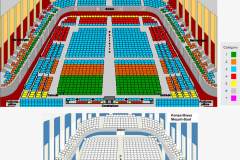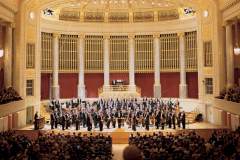Sabine Devieilhe and Mathieu Pordoy
Mo | Tu | We | Th | Fr | Sa | Su |
Images of Women and Lullabies
Soprano Sabine Devieilhe captivates with elegance, a palette of colors, and a nuanced diction. Since being awarded the title of "Révélation Artiste Lyrique" at the "Victoires de la Musique" in 2013, she has been in high demand on major stages as both an opera and concert singer, as well as a song interpreter. In this concert, she focuses on images of women and lullabies. She interprets works such as Richard Strauss’ "Mädchenblumen" about four female characters, Franz Liszt’s "Die Loreley," and songs by the two French composers Lili Boulanger and Germaine Tailleferre. Boulanger was the first woman to win the "Grand Prix de Rome" in 1913, while Tailleferre was the only woman in the composer group "Les Six" during the 1920s.
Program and cast
Sabine Devieilhe, Soprano
Mathieu Pordoy, Piano
Program
Franz Liszt
Die Loreley S 273/2 (1854–1856)
Lullabies Cycle:
Josef Hadar
Erew schel schoschanim "Evening of Roses"
Anonymous
Petit chat triste
Franz Schubert
Du bist die Ruh D 776 (1823)
Anonymous
Cossack lullaby
Franz Schubert
Nacht und Träume D 827 (1823)
Franz Liszt
En rêve. Nocturne S 207 (1885)
Richard Strauss
Meinem Kinde op. 37/3 (Six Songs) (1897)
Die Nacht op. 10/3 (Eight Poems from Last Leaves) (1885)
Franz Liszt
Oh! quand je dors "O komm im Traum" S 282/2 (1842)
Edvard Grieg
Ein Traum op. 48/6 (1884–1888)
***
Richard Strauss
Kornblumen op. 22/1 (Mädchenblumen) (1886–1888)
Lili Boulanger
Elle était descendue au bas de la prairie (Clairières dans le ciel) (1913–1914)
Elle est gravement gaie (Clairières dans le ciel) (1913–1914)
Richard Strauss
Mohnblumen op. 22/2 (Mädchenblumen) (1886–1888)
Lili Boulanger
Un poète disait (Clairières dans le ciel) (1913–1914)
Richard Strauss
Efeu op. 22/3 (Mädchenblumen) (1886–1888)
Lili Boulanger
Deux Ancolies (Clairières dans le ciel) (1913–1914)
Cécile Chaminade
Ma première lettre
Germaine Tailleferre
Non, la fidélité... (Six French Songs)
Mon mari m'a diffamée (Six French Songs)
Les trois présents (Six French Songs)
Francis Poulenc
Improvisation No. 15 C minor "Homage to Edith Piaf" (1959)
Darius Milhaud
Tay toy, babillarde arondelle op. 223/3 (Four Songs by Ronsard) (1940)
Margherite Angéle Monnot
Hymne à l'amour. Song (1949)
Wiener Konzerthaus
The Wiener Konzerthaus ( Vienna Concert House or Hall) is one of the largest and most artistically progressive institutions in international musical life. During the course of a season, which extends from September to June, some 750 wide-ranging events take place and more than 600,000 visitors can listen to around 2,500 different compositions. With this comprehensive and varied selection, the Wiener Konzerthaus – together with the Vienna State Opera House and the Musikverein – is central to Vienna’s reputation as one of the world’s leading music capitals.
From its earliest days, the Wiener Konzerthaus has held the highest cultural aims and artistic mission: «To act as a venue for the cultivation of fine music, as a meeting point for artistic endeavour, as a home for music and a cultural centre for Vienna». It was in this spirit that the Konzerthaus was inaugurated on 19 October 1913 with a festive concert attended by Emperor Francis Joseph I. To mark the occasion, Richard Strauss wrote the «Festliches Präludium op. 61», which was followed by Beethoven’s Ninth Symphony. This programme combination, comprising a contemporary work and a masterpiece from the past, served as a model for the Wiener Konzerthaus’s future direction: today, too, an awareness of tradition and the joys of innovation form the main pillars of the Konzerthaus’s artistic identity.
Access to the Wiener Konzerthaus
Public transport:
Short walk from the U4 Stadtpark Station: 10 min walk from the U4/U1 Karlsplatz Station, or take the 4A bus.
From the tram and bus stops at Schwarzenbergplatz, accessed by D, 2 & 71 trams and 3A & 4A buses. The 4a bus stop is at Hotel Am Konzerthaus.
Taxi:
The nearest taxi stands are at the Hotel Intercontinental in the Johannesgasse and at Hotel Am Konzerthaus on the Heumarkt.
Restaurants next to:
Gmoakeller
Hotels in immediate vicinity:
Hotel am Konzerthaus and Intercontinental
Great Hall
In the heart of the building (which consists of more than 600 rooms) lies the Konzerthaus’s flagship, the Grosser Saal (Great Hall). Designed with a sense of space and classical balance, its stage has provided the setting for many memorable concerts over the years. In this room, artists, audiences and atmosphere blend into a harmonious triad.
Home to world-famous orchestras, virtuoso soloists, renowned conductors and legendary jazz musicians, the Great Hall can accommodate an audience of 1,800 and offers the perfect venue for a wide variety of musical activity. The Great Hall has emerged from the major renovation with renewed splendour and, despite improvements in technical installation and audience comfort has continued to conserve its original elegance. Its unique atmosphere ideally lends itself to the broad range of artistic activities offered by the Vienna Konzerthaus.
Mozart Hall
Open and relaxing, welcoming and intimate, with its incomparable appeal, the Mozart Hall constitutes a jewel of international musical life. The perfect setting for all types of chamber music, from lute and Lieder recitals to string quartets and chamber orchestras, it can accommodate an audience of around 700 – an ideal size in which to experience the intimacy of chamber music and recital performances.
The Mozart Hall enjoys world-wide acclaim on account of its unique acoustics. This distinction makes it a top favourite with leading ensembles and soloists – as well as a popular venue for recordings. This was taken into account during the major renovation of the building: as with all other rooms in the Konzerthaus, the Mozart Hall is directly linked to a recording studio and a technical control room.
Schubert Hall
With its festive character, the Schubert-Saal presents the perfect model of a music salon, the restored use of the windows follwing the renovation having returned the room to its elegant, airy appearance.
Equipped with around 320 seats, it lends itself to a wide range of chamber-music concerts, as well as to receptions, dinners and lectures. It is home to the popular lunchtime concert series, as well as to events which enable promising young musicians to experience a professional concert stage. Many a musical career has been launched in the Schubert Hall of the Vienna Konzerthaus.
Seating capacity: 320
Auditorium: 240 m²
Podium: 50 m²

 EN
EN DE
DE IT
IT FR
FR ES
ES RU
RU JP
JP RO
RO
 Seating plan
Seating plan 